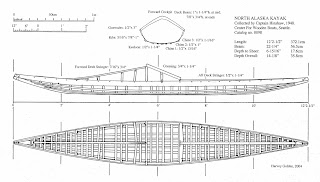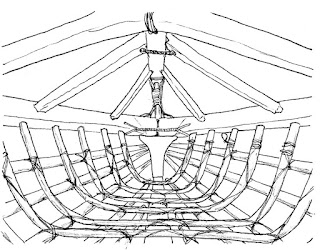This time, the books themselves are the subject, because Harvey Golden's Kayaks of Alaska (2015) and Kayaks of Greenland: The History and Development of the Greenlandic Hunting Kayak, 1600-2000 (2006) are huge, valuable, awesomely impressive, and worthy of an article about themselves. When I opened the mailing package that contained them, I was, without exaggeration, awestruck by the enormous quantity of sheer fact they contain and the clarity of its presentation. Having lived with them for a few months now, my opinion has not diminished a bit.
Golden is an independent researcher in the field of museum studies. He has examined and surveyed almost every historically significant kayak held in museum collections and many private collections in Europe and North America, taking off lines, photographing and sketching the most minute and intricate details, and delving into the collections' documentation and the historical, popular, and academic writings of others. When personally surveying an artifact, no detail seems to escape his notice. If a deck line had once been present on a kayak but was later removed, perhaps 200 years ago, Golden is certain to have detected it by the presence of a tiny nub of a thong cut off close to the deck.
Kayaks of Alaska and Kayaks of Greenland divide the boats surveyed by geographic and cultural ranges, each associated with different boat types. In the Greenland book, Golden creates a typology of eight types, although the distinctions between the types are sometimes difficult to see. Certainly, the kayaks of Greenland are more similar to one another than the kayaks of Alaska, where the differences between nine regional types Golden describes are in some cases really dramatic. Hereafter, we'll focus on the more recent Kayaks of Alaska. Kayaks of Greenland is similar in most respects.
 |
| A kayak from Point Barrow, from Kayaks of Alaska (Click any image to enlarge.) |
 |
| Lines of a North Alaska kayak in the Burke Museum, Seattle, from Kayaks of Alaska |
 |
| Construction plan of a North Alaska Kayak at the Center for Wooden Boats, Seattle, from Kayaks of Alaska |
 |
| Interior construction details of an Alaskan kayak, from Kayaks of Alaska |
 |
| Kayak builders, from Kayaks of Alaska |
A charming bonus in Kayaks of Alaska is a section of color plates containing reproductions of Golden's hand-drawn depictions of colored decorative details on many of the kayaks and paddles. Aside from this, all illustrations in both books are in black and white.
These are big, heavy books, each 8.5" x 11" and over 500 pages. As self-published projects, they are extraordinary for the quality of their production, but this is almost trivial compared to the quality and value of their contents. They are not books that many will sit down and read cover-to-cover, for the descriptions of thousands of details on dozens of kayaks do not make for an engaging narrative. But one can dip into them at any point and learn something about kayak history or about a particular design, and as reference sources, they are incomparable in their clear and comprehensive coverage of their subjects.
In the immense contribution they make to the study of indigenous watercraft, Golden's books stand as equals to Adney and Chapelle's The Bark Canoes and Skin Boats of North America and Haddon and Hornell's Canoes of Oceania. Kayaks of Alaska and Kayaks of Greenland are magnificent achievements.
* * *
Visit Harvey Golden's website to purchase Kayaks of Alaska and Kayaks of Greenland. IndigenousBoats.com has no business affiliation with Harvey Golden, and we make no commissions on sales of his books. 










